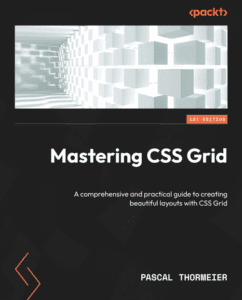Pascal Thormeier is the author of Mastering CSS Grid we got the chance to sit down with him and find out more about his experience of writing with Packt.
Q: How did you become an author for Packt? Tell us about your journey. What was your motivation for writing this book?
Pascal: When I started writing my blog on DEV, I’d never have thought I could call myself a published author in only a few years! I always wanted to write a book eventually, but the opportunity that Packt offered me in August 2022 took me off-guard.
They told me that they found my articles impressive and insightful. At first, I was afraid of writing a book, and I still can’t quite fathom how I managed to do it, but my gut feeling told me to accept the offer. I would’ve regretted not accepting it.
I want to share knowledge. I want to empower people and bring them forward, teaching them how to get the most out of the tools they use. We’re all standing on the shoulders of giants, and I’ve learned so much because of people readily sharing their knowledge. Once we discussed a possible outline, we signed a contract, and I was introduced to the team. From there, the process was very straightforward.
Q: What is the name of your book?
Pascal: Mastering CSS Grid: A comprehensive and practical guide to creating beautiful layouts with CSS Grid
Q: What kind of research did you do, and how long did you spend researching before beginning the book?
Pascal: I researched the history of the web and web development, focusing on design and how people used to structure websites. I also studied the CSS Grid and Flexbox in depth to gain a complete understanding; frankly, I even learned new things myself!
I researched several frameworks, their history, use cases, and their idea of grid structures. Most importantly, I studied how to teach the content best, really up my writing skills, and provide the best guide I could.
I’ve spent about a third of the total project time researching, the other two-thirds writing the content and creating all the code necessary to complement the text.
Q: What key takeaways do you want readers to come away with from the book?
Pascal: The first key takeaway is that CSS Grid is a tool like any other. It has its use cases, but the workshop should have additional tools, too.
Also, simply because we know how to use a tool doesn’t mean we know when and how to use it in specific circumstances. A holistic view helps to understand when to use alternatives.
The second key takeaway is that learning is fun, and sharing knowledge can help us progress in our careers. The third key takeaway is that grids are fundamental but can be nuanced in design and usability.
Q: Can you share any blogs, websites and forums to help readers gain a holistic view of the tech they are learning?
Pascal: I can recommend reading CSS Tricks (https://css-tricks.com), the MDN documentation (https://developer.mozilla.org/en-US/) and DEV (https://dev.to/).
Q. Did you face any challenges during the writing process? How did you overcome them?
Pascal: Oh, I very much did! Writer’s block, for example, is a real thing that I encountered more than once. However, it’s important not to pressure oneself too much.
There’s so much more to creating a book than simply writing it, and sometimes working on these other tasks first, like editing a previous chapter, polishing some code, or merely making a detailed outline for a chapter, may already be enough to get the creativity flowing again and dissolving the mental wall that keeps one from writing. Another challenge was keeping up with the fast development of new web technologies.
In fact, when the tech review was done, we found information in the first few chapters that already needed to be updated! The pace of modern web development is tremendous, and browsers support new features quite fast nowadays.
Q. How would you describe your author journey with Packt? Would you recommend Packt to aspiring authors?
Pascal: I recommend working with Packt. As a first-time author, I needed to figure out where to start, how to get the best out of my writing and how to deliver content explicitly meant to be read on paper or e-readers.
I’ve only written blog posts and online courses before, which are entirely different media, so I first needed to get accustomed. The people at Packt helped me a lot with this. They notched me in the right direction and were understanding and patient.
Q. Why should readers choose this book over others already on the market? How would you differentiate your book from its competition?
Pascal: I think there are more things to CSS Grid than “just learning the CSS specifications.” There are design principles we should follow, alternative tools that may fit a problem better and frameworks that allow us to build more complex applications with less effort.
This book distinguishes itself from others on the market by giving the reader a holistic view of CSS Grid and grids in general. There are real-life examples of good and bad practices.
The reader gets to do exercises on a project that is as close to an industry product as it gets, and a large selection of frameworks and a cheat sheet for the entirety of CSS Grid and all discussed frameworks and design principles makes this book a companion for everyday work. It will make the reader an expert on CSS Grid and many related topics.
Q. What is/are your specialist tech area(s)?
Pascal: Web development and software development in general.
Q. What advice would you give to readers jumping into this technology? Do you have any top tips?
Pascal: Regarding CSS Grid, my first advice is to learn about design, too. Knowing best practices are a tremendous help when implementing layouts, and learning about the thinking process of a design expert can help you greatly in co-working with them, making the team more effective, especially in the early phases of a project.
My second piece of advice is to learn about Flexbox as well. Often, these two tools complement each other and can help you create great products more efficiently.
My third piece of advice is to experiment with the tool. Try different setups, and use different approaches to the same problem. You’ll learn what works best, feels most intuitive and makes you the most efficient. Once you’re familiar with the nooks and crannies of the tool, you can focus more on the creative part of your job.
Q. What’s your take on the technologies discussed in the book? Where do you see these technologies heading in the future?
Pascal: CSS Grid, being a module of CSS itself, will develop further in the future. Some features are still actively discussed on GitHub, and the community is open to contributing too.
The tool itself is powerful as it lets us developers create complex layouts with less HTML and CSS code and decouple the structure of a document from its styling, which leads developers to want to use it more often, making it essential for modern web development. From a design perspective, grids are a fundamental tool as well.
They offer structure and visual rhythm and let us divide the page into logical units. With the introduction of CSS Grid, design experts and developers have a common language, which eases co-working and allows everyone to focus on what they can do best: Delivering excellent products.
Q. Do you belong to any tech community groups?
Pascal: I’m an active writer and reader on DEV (https://dev.to), one of the best communities I’ve ever participated in. The website features a wide variety of tech, experience levels and viewpoints, making it a very diverse source of information.
There are also meta-discussions about career advice, job interviews, roadmaps, and the platform itself. So if you’ve ever thought about writing or want to discuss new technology, DEV is the place for you!
Q. How did you organize, plan, and prioritize your work and write the book?
Pascal: The people at Packt helped me a lot. They’ve guided me through the process very well, discussing priorities with me and regularly checking on progress and milestones.
I worked on individual chapters by first thinking about the key messages I wanted to convey. Once I had these, I started dividing them into segments, often reordering them and trying to make the flow from one topic to the next as intuitive as possible.
Once I was satisfied with the details, I added them as titles to the chapter document, adding sub-titles and starting to write up individual sections. I often began with the summary since the information condensed there would influence the rest of the chapter.
Q. What are your favorite tech journals? How do you keep yourself up to date on tech?
Pascal: I follow a lot of excellent writers on DEV and YouTube. I don’t regularly read specific publications, such as magazines, because I want to see different takes on the same topics.
Q. Would you like to share your social handles? If so, mention them below.
Pascal: LinkedIn: https://www.linkedin.com/in/thormeier
Twitter: https://twitter.com/pthormeier
GitHub: https://github.com/thormeier
Personal website: https://thormeier.dev
Q: What is that one writing tip that you found most crucial and would like to share with aspiring authors?
Pascal: My number one piece of advice is simple: If you want to write, do it. Everyone has a unique perspective of the world, and perhaps your explanation of a topic is just the way of thinking someone else needs to read to understand the subject.
Even if there are countless posts or books on one topic (I’m looking at you, ToDo apps), everyone has a different approach to it, and your view is equally important and helpful as anyone else’s. There is no minimum required skill level.
You can find Pascal’s book on Amazon by following this link: Please click here









